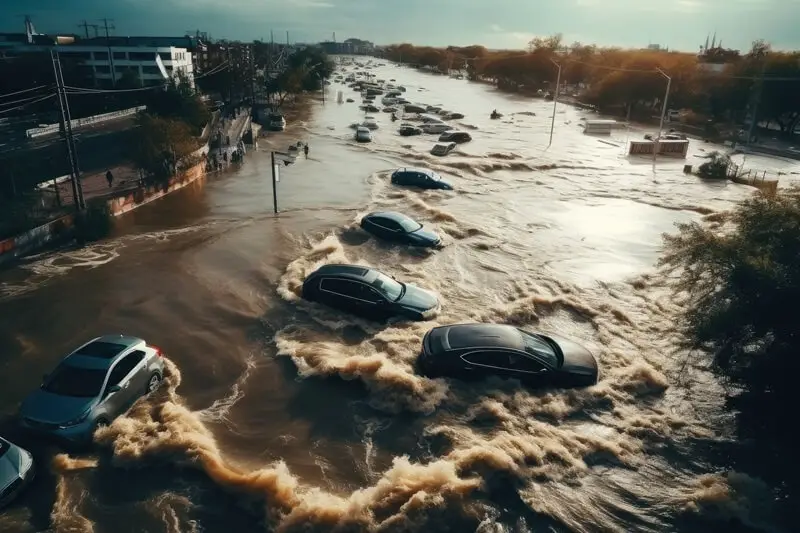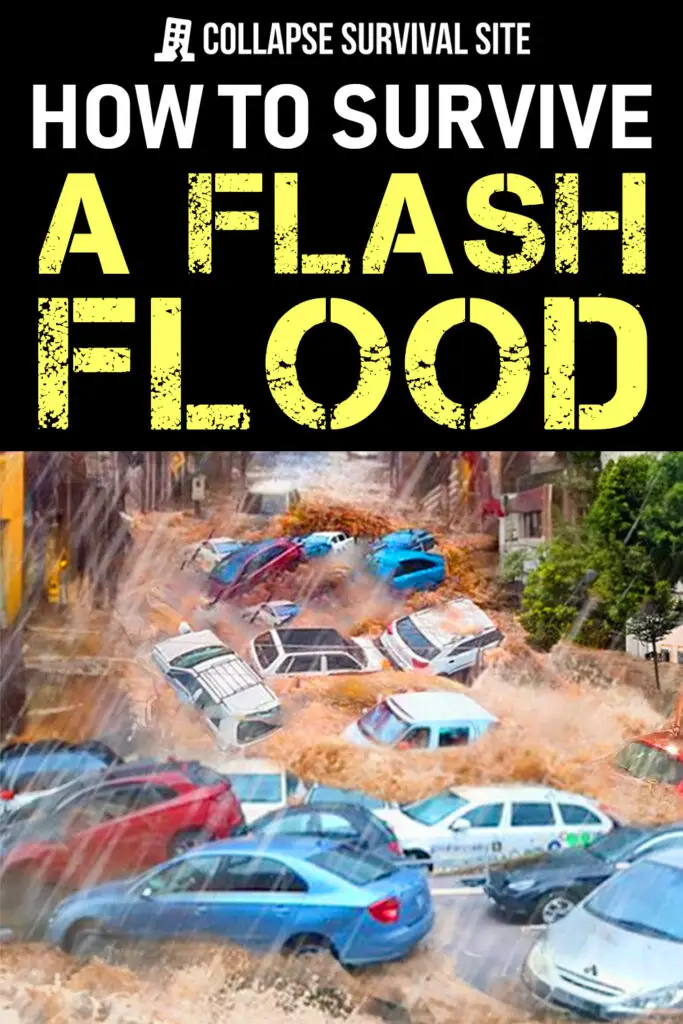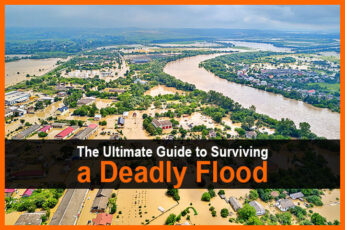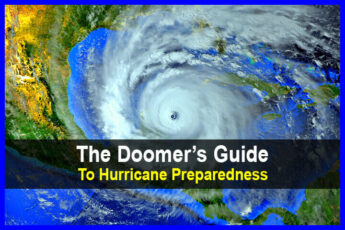Estimated reading time: 15 minutes
Unlike a regular flood, a flash flood occurs suddenly, often catching people off guard and bringing a wall of water often filled with debris. Flash flooding often accompanies heavy rainfall, but what makes a flash flood dangerous is that it can often travel long distances to locations where no rain is apparent.
It typically occurs where the ground isn’t able to absorb all the rainfall either due to previous precipitation, a recent wildfire stripping the land of vegetation, and even the hard surfaces of asphalt and concrete in cities. Flash floods can also occur due to dam or levee breaks, sending cascades of water into low lying areas.
Want to save this post for later? Click Here to Pin It On Pinterest!
The Growing Impact of Climate Change
The cascading effects of climate change has caused the number of flash floods to increase dramatically in recent years. As drought leads to wildfires and wildfires strip vegetation from the land, new and extreme weather patterns are bringing unprecedented precipitation worldwide.
Over the last 100 years, the average temperature has increased more than 2 degrees Fahrenheit. Each 1 degree rise adds 4% more water vapor to the atmosphere. It’s estimated that there is now more than 9% more water vapor in the air, leading to increased precipitation both in terms of frequency and amounts.
And that water has nowhere to go. As urban sprawl stretches more concrete and asphalt across cities, and as increasing wildfires continue to strip vegetation from the ground diminishing its ability to hold water, the heavier rainfall grows in volume as the runoff builds to flash floods.
The result is that flooding, and particularly flash floods, will become a growing threat to populations that are living more and more in flood plains and other high risk areas.
A Hidden Killer
Statistically, more people die from flash floods than from tornadoes or hurricanes. And while most deaths are caused by drowning, many people are killed or seriously injured by what's in the water.
For example, debris rushing through the flood waters, hidden hazards like deep holes unseen by murky water, obstructions that can catch a person’s arm or leg and drag them underwater, poisonous snakes trapped and carried in the floodwaters, and a range of toxins, bacteria, and viruses from overflowing sewers and other sources.
Flash Flood Alerts
There are various alert levels issued by local authorities when flash flooding is possible. They include:
Flash Flood Watch – A flash flood watch means that there is the potential for a flash flood and that people should be ready to take evasive action if necessary.
Flash Flood Warning – A flash flood warning means that a flash flood is either imminent or already occurring in the vicinity. People in the area are urged to find higher ground immediately.
Flash Flood Emergency – A flash flood emergency means that a flash flood is occurring in the immediate vicinity or is headed for an area threatening both life and catastrophic damage.
Flash Flood Definitions
Like anything else, there are terms and expressions used to define various actions and occurrences during a flash flood. Some of these seem obvious and some are bit obscure. Here are some of the terms and descriptions you may encounter before, when and after a flash food occurs.
Higher Ground
This seems easy enough if a hill or mountain is close by, but what if you live across a broad swath of farmland? Higher ground could be a tree or large boulder, even the roof of a shed or outbuilding.
In the city, a taller building like the roof of a parking garage or any other structure that is above the flood level marks higher ground. There are many videos of people taking refuge on taller structures during the Japanese Tsunami.
Higher ground could also mean the second floor of your home if caught by surprise or even the roof. One place that many agencies and experts say to avoid is an attic where you could become trapped if the flood waters rise over the level of your roof.
Even the roof of your car is a safer “high ground” location than inside the car during a flash flood. And a tree can get you above the flood waters if you’re trapped on foot during a sudden flash flood.
Debris Flow
The leading edge of a flash flood is often an accumulation of debris from the areas the water has flowed through. This debris is commonly made of trees, branches, and other scrub in natural or remote areas. It’s a very common occurrence when a flash flood runs over an area affected by a wildfire.
Urban areas also present their share of debris as many of the videos from the Japan tsunami demonstrated. In fact, cars, carts, garbage cans and anything else that can float found on the streets of a city can join the debris flow of an urban fast flood.
Turn Around, Don’t Drown
The phrase turn around, don’t drown was coined by the National Weather Service to serve as an easy to remember reminder to people in vehicles to avoid flashfloods. Almost half of all flash flood deaths are vehicle related because someone thought they could make it. It’s not worth the risk.
This danger is particularly extreme when water is rushing across a road or highway. It may seem like you could make it across, but it only takes 12-inches of water on the side of car to shift its direction and potentially cause it to float into the flowing flood waters.
And if you think you can make it in a truck or SUV, it only takes about 18-inches of water to take it downstream.
How to Survive a Flash Flood at Home

There’s not a whole lot you can do to protect your home from something as serious as a flash flood. Sandbags around the perimeter are the extreme solution but it’s very labor intensive and takes time.
Worse, there’s no guarantee that any sandbag wall will be high enough. Most of the survival advice for surviving a flash flood at home is about evacuation. Here are some preparations to take:
Have a Plan. Take the time to discuss with your family what you will all do in the event of a flash flood. Having this discussion isn’t a bad idea for any potential disaster, but if you live in an area prone to flooding the flood conversation is important.
Agree on a place where you will all meet up if you are separated due to work, school, or other activities. If you’re home and have to evacuate it can be nerve-wracking if other family members are out of the area or unaware. That’s a good reason to keep in touch with everyone as much as possible when any alerts for flash floods are issued.
If you have kids in school, ask the school what actions they take when there is a weather emergency like a flash flood. A lot of this depends on the school’s location and the potential for a flood, but it makes sense to know what’s happening with your kids while you’re thinking about an evacuation from your home.
Determine various evacuation routes you could drive to get to safe or higher ground. It’s possible that some highways and roads will be jammed with traffic in the event of an evacuation, so have a plan B.
Have a bug out bag packed and ready to go with all of the things you’ll need to survive on the road; at a hotel or family member’s house, or even in your car overnight. With any luck the flood waters will come and go in a day or two.
We would all be anxious to get home after the alert has been lifted not only to protect the house but assess the damage. It also makes sense to have a password protected thumb drive with key documents downloaded if you are away longer than planned.
Think about what you store in the basement. It’s the first place in a home to flood. If it’s valuable or subject to water damage, at least get it off the floor and better yet, upstairs or into the attic.
If you live in area prone to flooding think about flood insurance. Prices vary depending on a flood risk level measured from 1 to 10. If you’re at a high risk “10” you could inquire about federal flood insurance.
Stay connected not only to your family but to local weather alerts. Keep the weather channel on, have a weather alert activated on your smart phone, and have a hand-cranked solar radio as a backup so you can monitor events in case of a power outage.
Before you evacuate, throw the main circuit breaker to shut off electricity throughout your house. This will prevent damage to appliances due to shorts or surges.
- How To Stay Safe During a Flash Flood
- What If It’s Too Late To Bug Out?
- How to Create a Custom Bug Out Plan
- How to Build the Ultimate Urban Survival Emergency Kit
- 15 Creative Ways to Keep Looters Off Your Property
How to Survive a Flash Flood in a Vehicle

Flash floods are the greatest threat to people in vehicles. Roads and streets vary in elevation and grade and water will use the pavement as an urban streambed to accelerate and accumulate the flow.
Complicating everything is when water inevitably floods across a stretch of road. You can drive for miles in the rain without incident until you are stopped by a torrent of water rushing over the street. In short order, the depth and intensity increases and the question looms, “Should I try to make it across now before it’s too late?”
The answer is a definite no! In fact, be grateful that you are on a higher stretch of road and just back up and see if you can get to even higher ground. Remember the adage, “Turn around, don’t drown.”
If, in spite of your best efforts, your vehicle is swept into the flood you should take a few immediate steps.
Assess your location and the immediate threat. If your car is being rapidly swept away, stay in the vehicle. It’s possible to direct the vehicle by turning the steering wheel to some degree although your electrical system will soon shut down. What you’re looking for is a moment when your vehicle stops either with contact with the pavement or an obstruction.
Beware the hidden traps. Flash floods can wash away roadways. That could leave a steep drop-off or even a sink hole. The problem is that the rushing, murky water will obscure the trap and if you drive into it you could get stuck or worse. It’s best to simply not drive if surrounded by water in a flash flood, or at least limit your driving to a short distance to dry and high ground.
If your vehicle is stopped or stalls it’s time to get out and climb onto the roof of the vehicle. Open the windows if you can. If you can’t open them, break them with a tool you hopefully have in the glove compartment designed for that purpose.
Many will not have that tool, but you can pull out one of the head rests and use the metal rods in the base of the headrest to strike the window and break through.
Grab one of your seat belts as you carefully climb up and onto the roof. Help the kids and other family members up there first.
Once you’ve made it to the roof, call 911 if you can or try to alert someone in the area to your predicament and they hopefully will alert local emergency services.
Your chances of survival are better if you stay with or on top of your vehicle. You’ll be easier to spot and protected from debris and other dangers in the flood water.
If your battery and electrical system is still operating, turn on the warning flashers or headlights on your vehicle. A vehicle is easier to spot in flood waters, and flashing lights and people on the roof can and should draw plenty of attention.
If the flood waters continue to rise or your vehicle moves and you are swept into the water, you need to think about the next step.
About that vehicle survival kit in the trunk… Or maybe you forgot to pack one. Any number of things can happen when traveling anywhere at any time. Take the time to pack a small vehicle survival kit. You never know.
- 3 life-saving tactics to use if in a car during a flash flood
- What to do if your vehicle is submerged in water
- 50 Things to Put in Your Vehicle Survival Kit
- 15 First Aid Items to Keep In Your Vehicle
How to Survive a Flash Flood on Foot
Whether you’re walking home from work, shopping or camping, or swept from the roof of your vehicle – there are certain steps to take to survive a flash flood on foot.
Avoid the water. It may be tempting to just wade through to wherever you’re going, but even 6-inches of rapidly rushing water can sweep you off your feet.
You’re now at the mercy of the current and all of the debris and obstructions in the street as your body is scraped downstream with the current. If you come across a flash flood it’s time to once again –turn around, don’t drown.
Find high ground wherever you can find it. It could be a tree, large rock, or hill if you’re camping or outdoors. Trees, large trucks, upper stories of office buildings and parking garages, pedestrian overpasses, anything high and up and away from the water is the safest haven as a flash flood strikes and grows in intensity.
Call home. It’s part of the plan. Let family members know you’re okay so they don’t get in the car and go looking for you.
Carry a small survival kit. If you live in an area under any kind of threat, or know that bad weather is looking, wouldn’t it be nice if you had something to eat and drink and some extra cash and stuff? You never know.
How to Survive in an Underground Subway or Railway

This could be the worst case scenario in an urban environment. Water flows downhill and will quickly collect in underground train stations. Here are some steps to consider.
Get upstairs to street level as soon as possible. Even if the water is flowing down the steps, grab the banister and try to get up and out. It’s only going to get worse.
Avoid elevators. The last thing you want to do is find yourself trapped in a stopped and flooding elevator shaft. Elevators depend on electricity and water and electricity don’t mix.
If you’re trapped in the train and it’s starting to flood, the standard advice is to wait for the train conductor or engineer to make an announcement about what to do. That assumes the power to the train and the intercom is still working.
It also assumes that the people running the train know what to do. A lot depends on what’s happening inside and outside the train. If the flood waters keep rising getting out may be the only option, but what’s outside may be worse.
Avoid underground subways and trains if any alerts are issued for severe weather and potential flooding. If worse comes to worse, just take the day off or find another way to work or wherever else you may be going.
If You Are Swept into a Flash Flood
If, in spite of your best efforts, you are swept into a flash flood here are some steps to take.
Don’t immediately struggle to get back on your feet. Debris or an obstruction under water could trip you up.
Try to keep your feet downstream. Your knees are shock absorbers and could help to deflect you from debris or obstructions much better than your face, shoulders or head.
If you notice the water getting shallower or calm, try to get up and turn sideways to the water presenting the least resistance to the current. Move towards high ground or something you can at least cling to for support.
If the water is deep and flowing rapidly, swim sideways through the current to a structure, platform or high ground. Keep watch for people with poles, ropes, ladders or anything else extended to you to pull you out of the current. Here again, swim to calm water or anything that looks shallow or dry.
If you swallowed any water, and that’s quite possible. You should see a doctor. Ideally they prescribe you an antibiotic as a preventative measure. If you have any cuts or scrapes that were exposed to floodwater you should use a topical antiseptic as soon as possible with a bandage to prevent infection.
In fact, if you have spent any time in flood water, check your body for any cuts or old scrapes and treat them with a topical antibiotic like Neosporin. Flood water is sewer water in many areas.
- Instant Peril: Flash Floods (and How to Survive Them)
- Respiratory health harms often follow flooding: Taking these steps can help
- Can you get sick from floodwater?
Don’t Risk It
The most dangerous component of a flash flood is that it has a current. This isn’t the gradual rise in water levels you see with many floods, this is a river unleashed.
Worse is the debris that a flash flood carries towards everything in its path. Take any alerts for flash floods very seriously and either stay home, evacuate to high ground ahead of time, or simply bug out if you think the worst may be coming.
Flash floods kill more people than tornadoes or hurricanes and challenging the waters is just not worth the risk. Making matters worse is that climate change may lead to more flash flooding as a result of wildfires stripping the landscape of trees, and the increased weather extremes that continue to dominate the seasons.
The unfortunate result is that flash flooding may be a new risk we simply have to live with.
Like this post? Don't Forget to Pin It On Pinterest!








